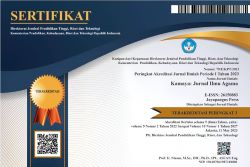Praktik Kesalehan Pemuda pada Kota Provincial
Studi pada Majelis At Tho’at
DOI:
https://doi.org/10.37329/kamaya.v7i3.3429Keywords:
Praktik kesalehan, Studi Kepemudaan, Placemaking, Kota ProvincialAbstract
Since the New Order collapsed in 1998, Islamization in Indonesia has become a mainstream movement. Evidence of mainstreaming Islamization is the increasingly common practice of piety in public spaces. One of the most common Islamization efforts is efforts to purify Islam through hijrah movement carried out by youth groups through popular culture media, such as through music in metropolitan cities in Indonesia such as Jakarta, Bandung and Yogyakarta. The hijrah movement is often carried out by targeting young people who have experienced transgressive life practices, causing the exploitation of space. This research aims to portray the practice of piety that occurs in provincial cities or second-class cities in the city dichotomy, according to Van Klinken. The research method used in this research is descriptive qualitative with a case study approach. Ethnographic data collection was carried out for six months, from November 2023 to May 2024, with the primary data source being a youth study collective in Purwokerto called Majlis At Tho'at. The findings of this research are that the At Tho'at Assembly's pious practices are carried out by creating two types of space that came from youth creativity in term to redefined hijrah movement. The first is a private room in the form of exclusive recitations, which are held regularly in the residence of one of the assembly members. The second is public space in the form of piety exhibitions in public spaces through a band, which is formed through social interaction in private spaces through recitations. The research results show that piety in provincial cities does not always exist in a binary dichotomy, which results in the exploitation of space as occurs in metropolitan cities. This is proven by the existence of spaces to negotiate a social phenomenon that occurs in a city.
References
Abdurrohman, A. A. (2018). Eksistensi Islam Moderat Dalam Perspektif Islam. Rausyan Fikr : Jurnal Pemikiran Dan Pencerahan, 14(1), 29–41.
Akmaliah, W. (2020). The Rise of Cool Ustadz: Preaching, Subcultures, And The Pemuda Hijrah Movement. In The New Santri: Challenges to Traditional Religious Authority in Indonesia 239–258. Singapore: ISEAS–Yusof Ishak Institute
Annisa, F. (2018). Hijrah Milenial: Antara Kesalehan dan Populism. Maarif, 13(1), 38–54.
Aras, R. (2019). Naqshbandi Sufis and Their Conception of Place, Time and Fear on the Turkish-Syrian Border and Borderland. Middle Eastern Studies, 55(1), 44–59.
As’ad, M., Lazib, I., & Iryan, R. (2023). Bermain atau Sepenuhnya Meninggalkan Musik: Dua Narasi Artis Hijrah pada Hukum Bermain Musik. Tebuireng: Journal of Islamic Studies and Society, 4(1), 1–17.
Azizah, A. N., & Rohmadi, Y. (2022). Dzikir Ratib Al-Haddad As an Effort To Strengthen Religious Character Education. Edureligia: Jurnal Pendidikan Agama Islam, 6(1), 89–98.
Azra, A. (2018). Kesalehan dan Politik: Islam Indonesia. Studia Islamika, 25(3), 639–650.
Dahlan, Z. (2018). Kebijakan Pemerintah Orde Baru Terhadap Majelis Ta’Lim (Studi terhadap Penguasa Orde Baru yang Memanfaatkan Pendidikan untuk Kepentingan Politik). Al Fatih: Jurnal Pendidikan Dan Keislaman, I(1), 123–152.
Fitriansyah, N. (2023). Cultivating Online Fun Fatwa in Contemporary Indonesia: Millenial, Piety, and New Religious Authority. Religio: Jurnal Studi Agama-Agama, 13(1), 117–135.
Fuad, S. (2020). Gerakan Hijrah dan Konstruksi Emosi Keislaman di Perkotaan. Mimbar: Agama Dan Budaya, 37(1), 53–61.
Gazali, G., & Efendi, E. (2023). Urban Sufisme Eksistensi Tasawuf di Perkotaan. Majalah Ilmiah Tabuah: Talimat, Budaya, Agama Dan Humaniora, 27(1), 49–56.
Guerra, P. (2018). Raw Power: Punk, DIY and Underground Cultures as Spaces of Resistance in Contemporary Portugal. Cultural Sociology, 12(2), 241–259.
Guerra, P. (2020). Other Scenes, Other Cities and Other Sounds in the Global South: DIY Music Scenes beyond the Creative City. Journal of Cultural Management and Cultural Policy/Zeitschrift Für Kulturmanagement Und Kulturpolitik, 6(1), 55–76.
Hamudy, N. A., & Hamudy, M. I. A. (2020). Hijrah Movement in Indonesia: Shifting Concept and Implementation in Religiosity. JSW (Jurnal Sosiologi Walisongo), 4(2), 133–150.
Hasanah, U., & Aisa, A. (2021). Konsep Hijrah Kaum Millenial (Kajian Media dan Dakwah). Al-MUNZIR, 14(2), 137–152.
Hefni, W., & Muna, M. K. (2022). Pengarusutamaan Moderasi Beragama Generasi Milenial melalui Gerakan Siswa Moderat di Kabupaten Lumajang. Jurnal SMART (Studi Masyarakat, Religi, Dan Tradisi), 8(2), 163–175.
Hidayat, D. (2012). Gerakan Dakwah Salafi di Indonesia pada Era Reformasi. Masyarakat Jurnal Sosiologi, 17(2), 1–19.
Himawan, R. N., Maharani, T. A., & Himmawan, D. (2024). God and Divinity (Analysis of Surah Al-Baqarah 165 and Surah Al-Ikhlas). Quality: Journal of Education, Arabic and Islamic Studies, 2(2), 129–139.
Imawan, D. H. (2022). Musik Indonesia Persepektif Budaya Dan Hukum Islam. Prosiding Seminar Nasional Hasil Penelitian Dan Pengabdian Masyarakat Universitas Islam Indonesia, Yogyakarta, 38–52.
Jati, W. R. (2017). Investigating the Political Base of Indonesian Middle Class: A Comparative Study. Komunitas: International Journal of Indonesian Society and Culture, 9(2), 267–282.
Khatimah, K. (2015). Peran Tokoh Agama Dalam Pengembangan Sosial Agama. Laporan Penelitian Individual. Purwokerto: Universitas Islam Negeri Prof. K.H. Saifuddin Zuhri
Khodijah. (2023). Tarekat and The Islamic Moderation on Digital Media: A Critical Study of JATMAN’s Site at Jatman.or.id. Religio: Jurnal Studi Agama-Agama, 13(1), 92–116.
Meiranti, M. (2019). Fenomena Hijrah Di Era Milenial Dalam Media Sosial. Ath Thariq Jurnal Dakwah Dan Komunikasi, 3(2), 148.
Mustofa, I., Juliansyahzen, M. I., & Hefni, W. (2023). Hijrah and changing religious preferences in contemporary Islamic legal practice. Ijtihad: Jurnal Wacana Hukum Islam Dan Kemanusiaan, 23(1), 115–138.
Naafs, S. (2012). Meniti Transisi dari Sekolah Menuju Dunia Kerja di Kota Industri Indonesia : Pendahuluan : Transisi Pemuda dalam Perekonomian yang Berubah. Jurnal Studi Pemuda, 13(1), 138–152.
Naafs, S., & White, B. (2012). Generasi Antara: Refleksi tentang Studi Pemuda Indonesia. Jurnal Studi Pemuda, I(2), 89–106.
Nasrillah, M., Rizky, F., & Arief, A. (2024). Optimizing The Role Of Da’wah Bil Hal For The Young Generation In The Modern Era. Quality: Journal of Education, Arabic and Islamic Studies, 2(1), 79–92.
Noviansah, G. A., Istiyanto, S. B., & Novianti, W. (2023). Negosiasi Islam dalam Budaya Ritual Lengger Banyumas. Jurnal Pendidikan Tambusai, 7(1), 1455-1464.
Papineau, É. I. (2019). Hey! Ho! Let’s Go [Back to Islam]!: Exploring the Interplay of Punk and Piety in Java, Indonesia. Motreal: Université de Montréal.
Papineau, É. I. (2020). At the Crossroads of Piety and Ageing:" Punk Hijrah" in Java, Indonesia. MUSICulture, 47, 164–188.
Priyanto, A. (2022). Interpretasi Hijrah dalam Rebranding Normativitas Islam. Syariati: Jurnal Studi Al-Qur'an dan Hukum, 8(2), 213-228.
Putra, F. F. (2017). Salam Satu Jari: Politik ‘Ruang’ dalam Skena Musik Underground. In Irfan R. Darajat (Ed.), Lanskap: Mosaik Musik dalam Masyarakat 57–88. Yogyakarta: Yayasan Kajian Musik Laras.
Putri, S. A. R. (2021). Hijrah Sebagai Gaya Hidup Generasi Digital Native Urban. Jurnal Komunika Islamika : Jurnal Ilmu Komunikasi Dan Kajian Islam, 8(2), 64.
Qodir, Z. (2018). Kaum Muda, Intoleransi, dan Radikalisme Agama. Jurnal Studi Pemuda, 5(1), 419-429.
Qomaruzzaman, B., & Busro, B. (2021). Doing Hijrah Through Music: A Religious Phenomenon Among Indonesian Musician Community. Studia Islamika, 28(2), 385-412.
Rachmadhani, A. (2015a). Kearifan Lokal pada Komunitas Adat Kejawen Bonokeling. Jurnal harmoni.Kemenag.Go.Id, 14(1), 170–185.
Rachmadhani, A. (2015b). Penyuluhan Agama Bagi Komunitas Masyarakat Adat Kejawen Di Kabupaten Banyumas. Jurnal Komunikasi Profetik Semarang, 8(1), 37-51.
Rakhmat Nur Hakim. (2014). Gerakan Islam Politik Fundamentalis: Kasus Hizbut Tahrir Indonesia di Surabaya. Jurnal Review Politik, 4(2), 207–231.
Ricklefs, M. . (2012). Islamisation and Its Opponents in Java: A Political, Social, Cultural and Religious History, c. 1930 to Present (First Edit). Singapore: Nus Press.
Rizkidarajat, W. (2017). Black Metal di Kemranjen, Banyumas: Negosiasi Black Metal dan Pesantren Melalui “Penjara Nurani.” In Irfan R. Darajat (Ed.), Laras: Mosaik Musik dalam Masyarakat. Yogyakarta: Yayasan Kajian Musik Laras.
Rizkidarajat, W., Mutahir, A., Chusna, A., & Taufiqurrohman, M. (2023). Tracing the Influence of Sharia-Based Local Regulations on Students’ Clothing in Public Schools. KnE Social Sciences, 2023, 275–287.
Rizkidarajat, W., Mutahir, A., Hanny, I., & Caceres-correa, I. (2024). Urban space spatiality in Purwokerto , Jawa Tengah : Case from Gedung Soetedja. Jurnal Ilmiah Ilmu Sosial Sosiohumaniora, 10(2), 118–137.
Rizkidarajat, W., Rahmadona, A. E., & Geminove, M. J. (2024). Kolektif Pemuda dan Placemaking : Penciptaan Ruang Alternatif oleh Heartcorner Collective , Purwokerto. Jurnal Penelitian Inovatif, 4(2), 205–216.
Rohit, M. M. (2023). Gerakan Islam Pasca Orde Baru: Kelahiran FPI dan Dampaknya. Journal of Islamic History And Civilization, 2(1), 1–15.
Rosyidah, I., & Damastuti, R. I. (2023). Membingkai Identitas Kolektif Berbasis Agama: Pengalaman Gerakan Indonesia Tanpa Pacaran. Dialog: Jurnal Penelitian Dan Kajian Keagamaan, 46(2), 203–214.
Saefullah, H. (2017). Here ’ s the hijrahs ’ 1 : Punk and The Religious Turn in the Contemporary Indonesian Underground Scene. Punk & Post-Punk, 6(2), 263–290.
Saefullah, H. (2022). More Than Just Devotion’: The Conservative Turn Among Subcultural Muslim Youths in the Indonesian Underground Music Scene. Muslim Politics Review, 1(2), 117–152.
Saloom, G. (2021). Understanding “Hijrah and Atonement” among Indonesian Celebrities: Social Psychology and Psychology of Religion Perspectives. Dialog: Jurnal Penelitian Dan Kajian Keagamaan, 44(2), 204–215.
Saputra, E. (2022). Hybrid Identity of Urban Muslim Youth: The Case of Teras Dakwah Yogyakarta. Esensia: Jurnal Ilmu-Ilmu Ushuluddin, 23(1), 120-134.
Saputra, S., Ishomuddin, Wahyudi, & Saleh, A. (2024). Boundary Works as a Mechanism For Forming Collective Identity in The Indonesian Middle Class Muslim Social Piety Movement. Ilomata International Journal of Social Science, 5(1), 14–32.
Schaefer, S. (2021). Islam Nusantara – The Conceptual Vocabulary of Indonesian Diversity. Islam Nusantara: Journal for the Study of Islamic History and Culture, 2(2), 312-328.
Sholihah, M., Maarif, M. A., & Romadhan, M. S. (2021). Konseling Islam Dengan Dzikir Tarekat Qadiriyah Naqsabandiyah: Mengatasi Kegelisahan Jiwa Dan Bathin. Al-Afkar, Journal For Islamic Studies, 4(2), 299–317.
Susilo, W. (2021). Bunga Rampai Indonesia (dan Islam) Masa Kini. Islam Nusantara: Journal for the Study of Islamic History and Culture, 2(2), 117–125.
Sutopo, O. R., Wibawanto, G. R., & Lukisworo, A. A. (2020). Melampaui Subkultur/Post-Subkultur: Musisi sebagai Jalan Hidup Kaum Muda. Jurnal Studi Pemuda, 9(1), 1–12.
Syamsuddin, & Fatkhan, M. (2010). Dinamika Islam Pada Masa Orde Baru. Jurnal Dakwah, 11(2), 139–156.
van Klinken, G. (2014). Democracy, Markets and the Assertive Middle. In G. Van Klinken & W. Berenschot, In Search of Middle Indonesia, 1–36.
Zarkasyi, F. I., & Effendi, I. (2023). Moderasi Islam Sebagai Diplomasi Publik Arab Saudi di Indonesia. Jurnal ISIP: Jurnal Ilmu Sosial Dan Ilmu Politik, 20(1), 19–32.
Downloads
Published
How to Cite
Issue
Section
License
Copyright (c) 2024 Kamaya: Jurnal Ilmu Agama

This work is licensed under a Creative Commons Attribution-ShareAlike 4.0 International License.
An author who publishes in the Kamaya : Jurnal Ilmu Agama agrees to the following terms:
- Author retains the copyright and grants the journal the right of first publication of the work simultaneously licensed under the Creative Commons Attribution-ShareAlike 4.0 License that allows others to share the work with an acknowledgement of the work's authorship and initial publication in this journal
- Author is able to enter into separate, additional contractual arrangements for the non-exclusive distribution of the journal's published version of the work (e.g., post it to an institutional repository or publish it in a book) with the acknowledgement of its initial publication in this journal.
- Author is permitted and encouraged to post his/her work online (e.g., in institutional repositories or on their website) prior to and during the submission process, as it can lead to productive exchanges, as well as earlier and greater citation of the published work (See The Effect of Open Access).
Read more about the Creative Commons Attribution-ShareAlike 4.0 Licence here: https://creativecommons.org/licenses/by-sa/4.0/.





